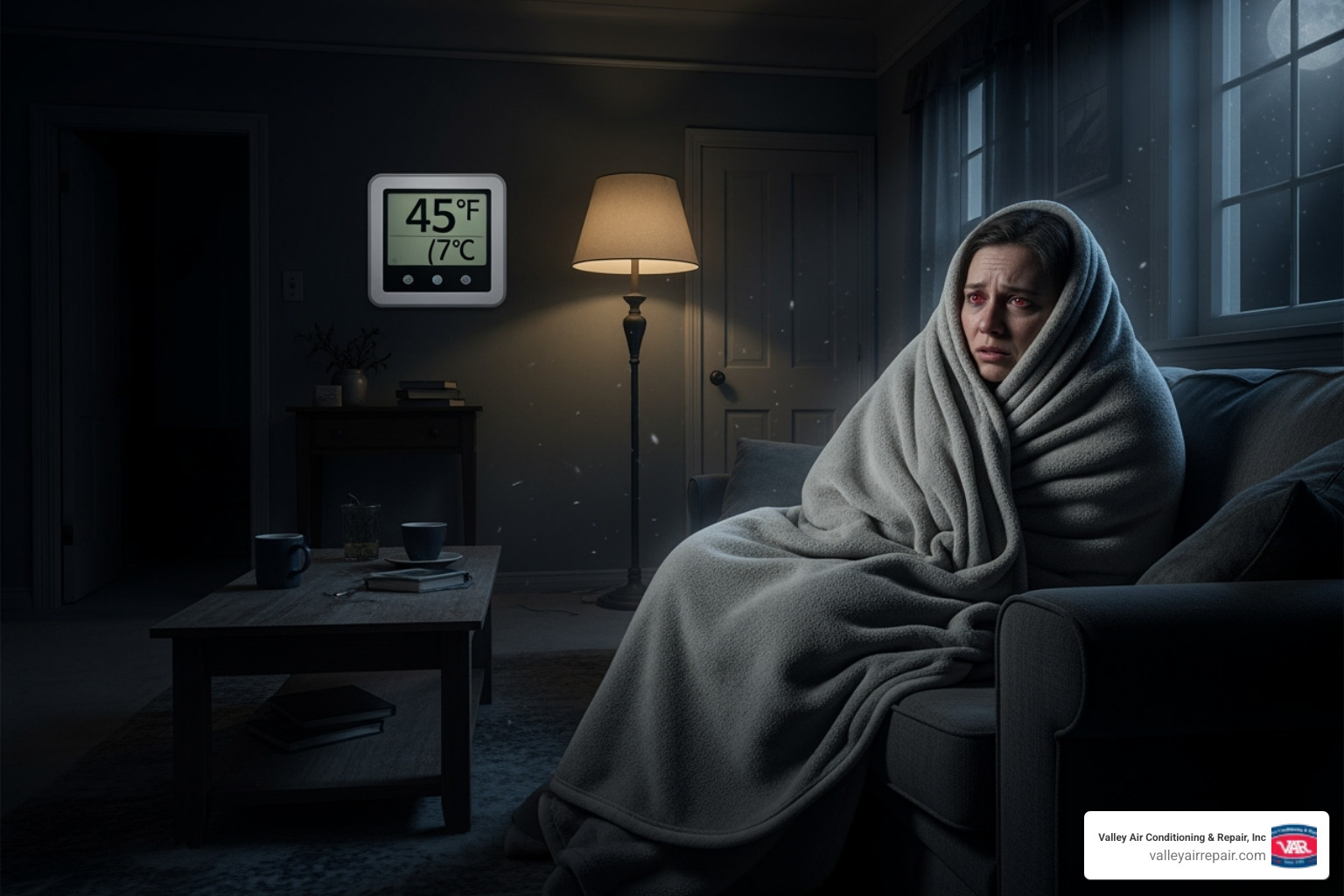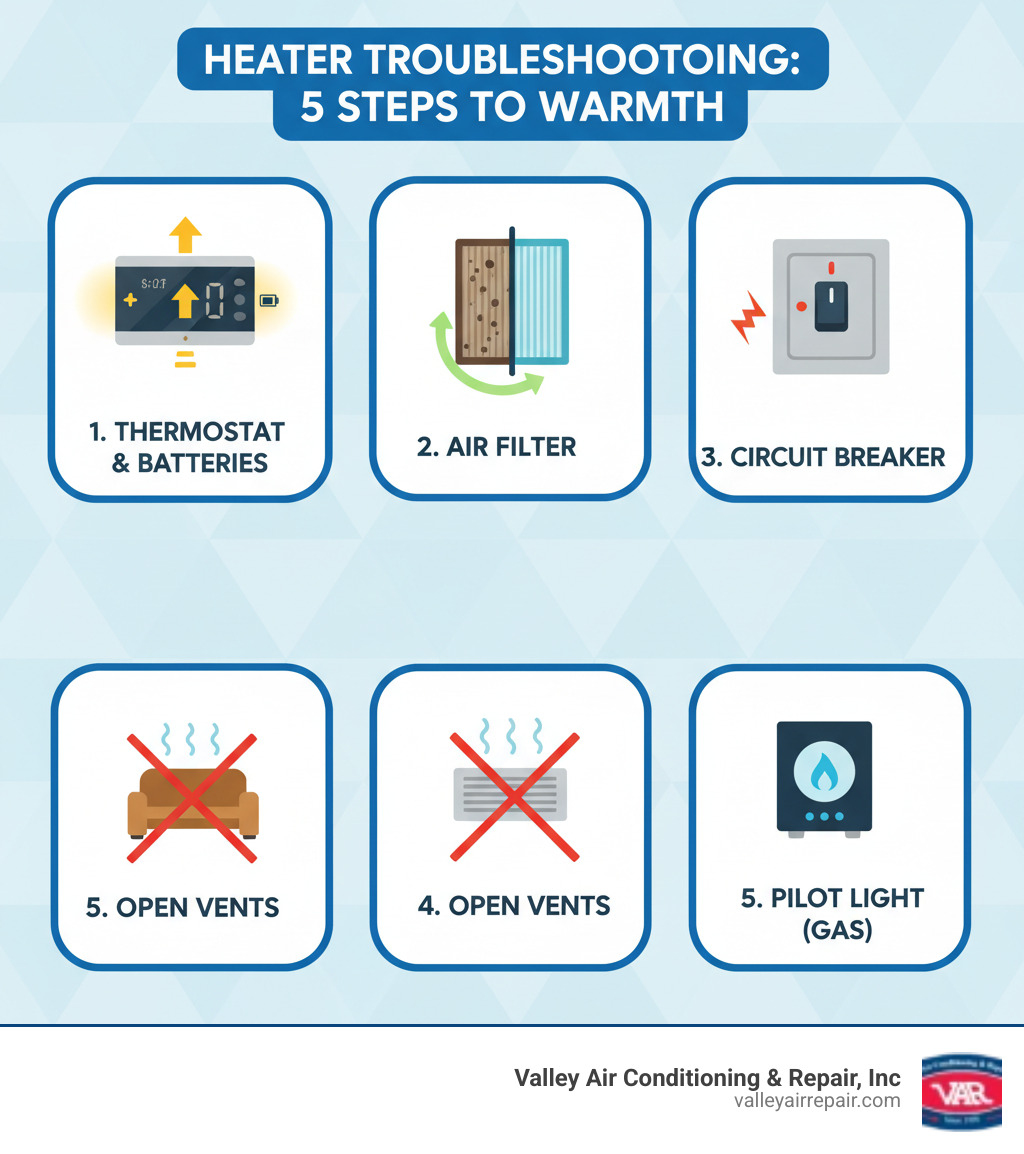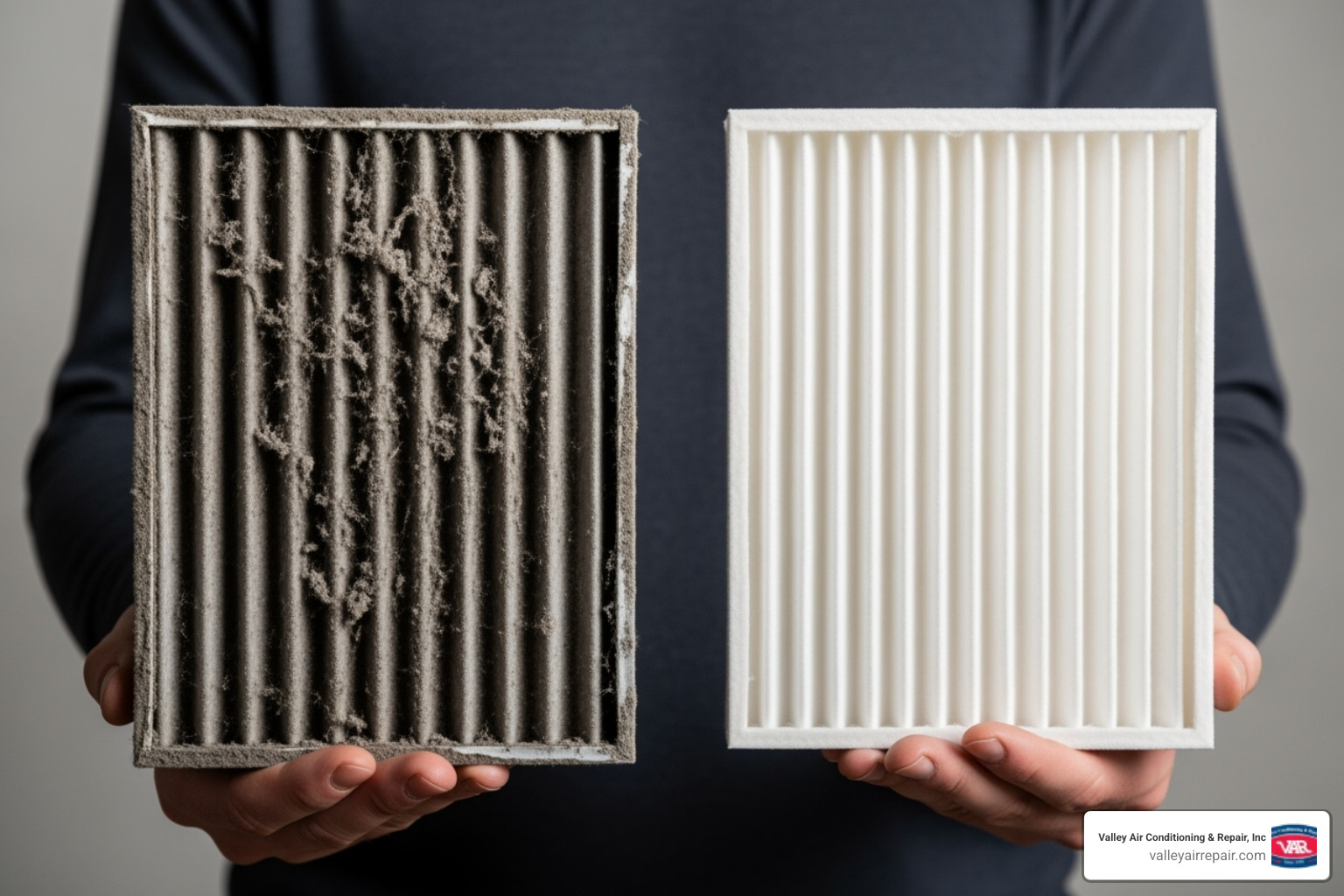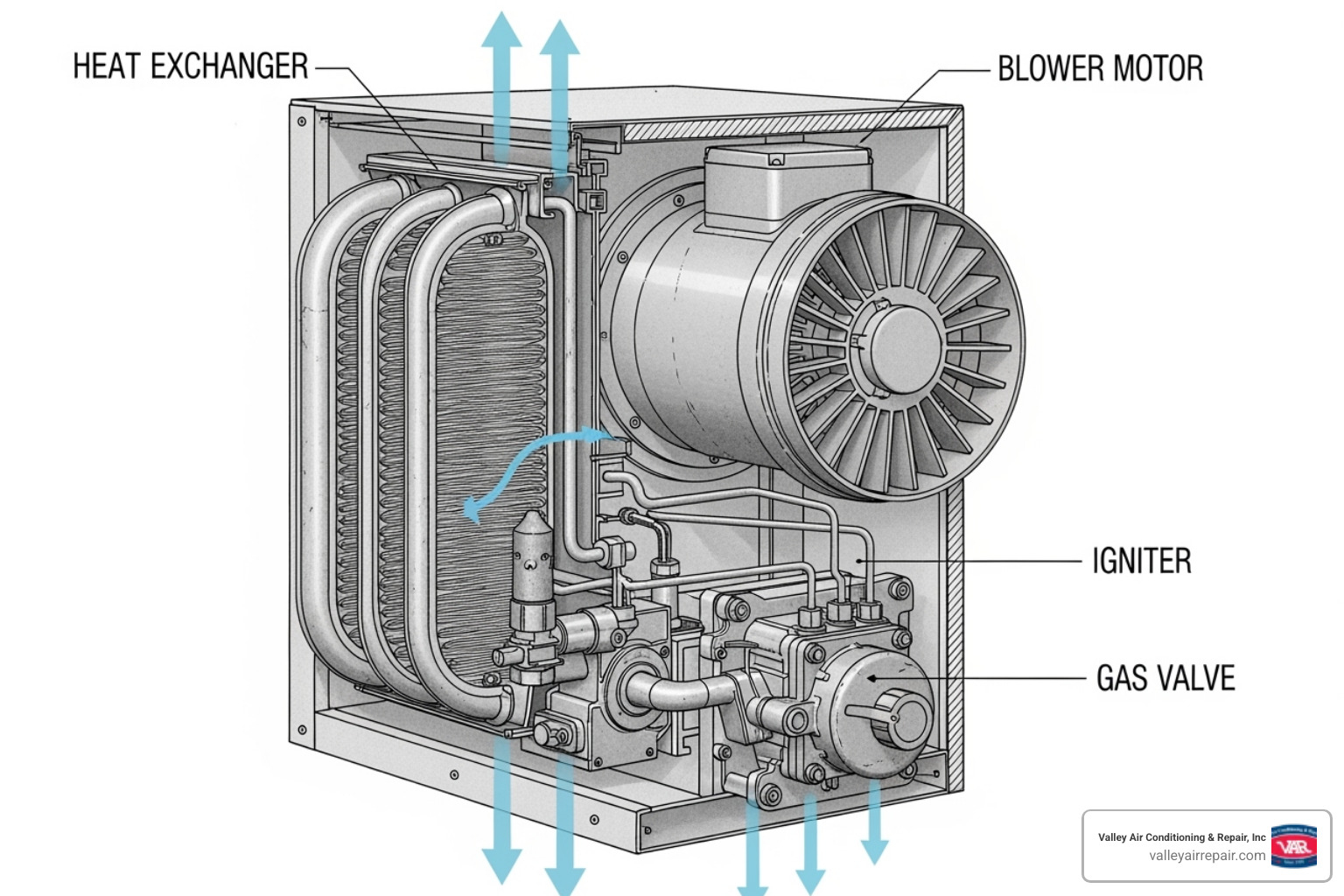The Ceres Heater Whisperers: Solving Your "Not Working" Woes

When Your Heater Fails on a Cold Ceres Night
Heater not working ceres searches spike every winter when families wake up to freezing homes and realize something's wrong. If you're reading this at 2 AM wrapped in blankets, here's what you need to know right now:
Quick Action Steps for a Non-Working Heater:
- Check your thermostat - Make sure it's set to "heat" mode and the temperature is higher than your current room temperature
- Look at your circuit breaker - A tripped breaker is an easy fix that takes 30 seconds
- Inspect your air filter - A clogged filter is the #1 cause of heating problems
- Check all vents - Make sure furniture or curtains aren't blocking airflow
- Look at your pilot light - If you have a gas furnace, confirm the pilot light is lit and blue
Some of these fixes take less than a minute. Others mean it's time to call a professional.
Ceres winters might not be Minnesota-cold, but when temperatures drop into the 30s and 40s at night, a broken heater isn't just uncomfortable - it's a safety issue. According to research from local HVAC providers serving the Central Valley, the average furnace lasts 10-15 years, and many Ceres homes are reaching that replacement threshold.
The good news? Most heater problems fall into predictable categories. Strange noises, weak airflow, and cold air from vents are the most common complaints HVAC technicians hear. Some you can fix yourself. Others need an expert.
This guide walks you through the troubleshooting process step-by-step, helping you understand what's happening with your heating system and when it's time to call for backup.

First-Response Troubleshooting: Simple Checks for Your Heater
Before calling a professional, take a few minutes for some simple checks. Many heater not working ceres issues are surprisingly easy to fix, as we've learned since 1970. These diagnostics will help you determine if it's a simple fix or time to call a professional.
Is Your Thermostat the Culprit?
Your thermostat controls your heating system, and a simple miscommunication can cause a heater not working ceres problem.
Start with the obvious: Is your thermostat set to "Heat" mode? It's surprisingly common for it to be accidentally switched to "Cool" or "Fan Only."
Next, check your temperature setting. Your heater won't turn on if the target temperature is set below the current room temperature. Make sure it's set a few degrees higher.
Dead batteries are another sneaky culprit. If the thermostat display is dim, blank, or flickering, try replacing them.
Got a smart thermostat? Check your Wi-Fi connection and ensure automated schedules aren't overriding your settings. If you're concerned about how your smart thermostat handles your data, you can review more info about smart thermostats and their privacy implications.
Also, consider your thermostat's location. If it's near a draft, heat source, or in direct sun, it can get inaccurate readings and cause uneven heating.

The Importance of Clean Airflow
Restricted airflow is the most common reason for a heater not working ceres call, forcing your system to struggle to circulate air.
Clogged air filters are the top suspect. A filter packed with dust and debris prevents air from passing through. This forces your system to work harder, raising energy bills and causing strain that can lead to overheating and shutdowns. Check your filter monthly during winter and replace it when it looks dirty.
Blocked vents and registers are the second airflow killer. Walk through your home and ensure furniture, rugs, or curtains are not blocking any supply or return air vents. Even partial blockages can strain your system.
Deeper problems can include ductwork issues like leaks, crushed sections, or blockages. Leaky ducts are especially wasteful, sending heated air into your attic or crawlspace instead of your rooms. Symptoms of poor airflow include uneven heating, weak output from vents, and a constantly running heater.

Beyond thermostats and airflow, check your circuit breaker and flip it back on if it's tripped. If you have a gas furnace, look at your pilot light. It should be a steady blue flame; if it's out or yellow, it needs attention.
These simple checks will help you know if you're dealing with a quick fix or something that needs professional eyes. If these steps don't get your heat flowing again, it's time to call in someone who can dig deeper.
Why Is My Heater Not Working in Ceres? Common Culprits Explained
When the basic troubleshooting steps don't bring the heat back, you're likely dealing with something more involved. The good news? Most heater not working ceres problems fall into recognizable patterns. After decades of service calls, we've seen these issues countless times, and understanding them can help you know what to expect when a technician arrives.
Heating systems have quite a few moving parts working together behind the scenes. When one component fails, it can throw everything off balance. You might notice insufficient heat that barely takes the chill off, uneven heating where your bedroom feels like the Arctic while your living room is toasty, or no heat at all. These symptoms tell different stories about what's happening inside your furnace.
The blower motor is your system's workhorse, pushing warm air through your ducts and into your rooms. When it starts struggling or fails completely, you'll know it. Sometimes the heat is there, but it's not going anywhere because the blower won't run. Other times, the problem lies with the ignition system that's supposed to light the burners in your gas furnace. No ignition means no flame, and no flame means no heat.
If you have a gas furnace, gas supply problems can stop everything in its tracks. Maybe the gas valve got accidentally turned off during cleaning, or there's an issue with the line itself. If you ever smell that distinctive rotten egg odor that gas companies add as a safety measure, don't investigate further. Get everyone out of the house and call your gas company immediately.
For a deeper understanding of how all these components work together, you might find an explanation of how heating systems work helpful. Knowing the basics can make conversations with your HVAC technician more productive.
Decoding Strange Heater Noises
Your heater has a voice, and it's trying to tell you something when it starts making unusual sounds. That gentle whoosh of warm air starting up? That's normal. But banging, grinding, squealing, or clicking that wasn't there before? That's your system asking for attention.
Banging or clanging sounds often come from ductwork expanding and contracting as it heats and cools. It's usually harmless, though annoying. But if the banging is coming from inside the furnace itself, you might have loose parts rattling around or components that have worked themselves free from their mountings. These need to be secured before they cause more damage.
Grinding noises are never a good sign. They typically mean metal is rubbing against metal somewhere it shouldn't be. The blower motor bearings might be wearing out, or the fan wheel could be scraping against its housing. This is one of those sounds that says "call someone soon" before it becomes "call someone right now."
A squealing sound that makes you wince? That's often a belt issue in older furnaces that use them. The belt might be loose, worn out, or just need some adjustment. Some newer systems don't use belts, so if you have a modern furnace making this sound, it could be the blower motor itself crying out for help.
Clicking is the trickiest to interpret. You'll hear some clicking as your furnace starts up and shuts down. That's just electrical components and gas valves doing their job. But continuous clicking without the furnace actually lighting? That suggests your ignition system is trying and failing repeatedly. The igniter might be failing, or the flame sensor could be dirty and not recognizing that a flame is present.
These noises aren't just annoying background music for your winter evenings. They're early warning signs that worn-out components need attention before they fail completely and leave you in the cold.

Advanced Problems Causing Your Heater Not to Work in Ceres
Some heating problems go beyond the DIY field and venture into territory where you really want a trained professional handling things. These issues can involve safety concerns or complex components that require specialized knowledge and tools.
Take the faulty limit switch, for example. If your blower runs continuously without ever shutting off, even when your home is plenty warm, this little switch might be stuck or malfunctioning. It's designed to sense when the furnace has cooled down enough to stop the blower. When it fails, your blower just keeps running and running, wasting energy and wearing itself out.
A cracked heat exchanger is one of the most serious problems a furnace can develop. This metal chamber is where combustion happens, and it's designed to separate the flames and exhaust gases from the air that circulates through your home. Over time, the constant heating and cooling cycles can cause metal fatigue and cracks. This creates a carbon monoxide risk that's genuinely dangerous.
Carbon monoxide is the silent threat every homeowner should take seriously. You can't see it, smell it, or taste it, but it can make you seriously ill or worse. If your pilot light burns yellow or orange instead of a steady blue, that's incomplete combustion and a red flag. Same goes if you notice soot buildup around your furnace. These are signs that something's wrong with the combustion process, and carbon monoxide might be leaking into your living space.
The malfunctioning ignition control is another complex issue. Modern furnaces use sophisticated electronic ignition systems instead of old-fashioned pilot lights. When these fail, your furnace won't light at all, or it might try repeatedly and give up. Sometimes the flame sensor gets coated with residue and can't detect that the burners have actually lit, so it shuts everything down as a safety precaution.
These advanced problems show why professional diagnosis matters. We've been doing this since 1970, and we've seen it all. More importantly, we have the equipment to test for carbon monoxide, the expertise to safely inspect gas systems, and the knowledge to identify problems before they become emergencies. Your comfort matters, but your safety matters even more.

Repair or Replace? Making the Right Call for Your Ceres Home
Deciding whether to repair your existing heater or invest in a new one can feel like a tough choice. While we always aim for the most cost-effective solution for our customers, sometimes, repairing an old, ailing system is like pouring money into a leaky bucket. We've been serving the Valley since 1970, and over those decades, we've learned a thing or two about when it's time to say goodbye to an old heating system.
Key Signs It's Time for a Heater Replacement
The average lifespan of a furnace is typically 10-15 years. If your heater is approaching or has exceeded this age, and you're experiencing any of the following signs, it might be time to consider a replacement:
- Frequent Repairs: Are you calling us for repairs every winter? Frequent breakdowns on an old heater can quickly become more costly than investing in a new, reliable appliance. If we're on a first-name basis with your heater's repair history, it might be a hint!
- Rising Energy Bills: An old, inefficient heater has to work much harder to warm your home, leading to significantly increased energy consumption. If your heating bills are steadily climbing without a change in usage or energy costs, your heater is likely losing its efficiency.
- Uneven Temperatures: Do some rooms feel like a sauna while others are an icebox? Uneven heating can be a sign of an undersized or failing system, or issues with your ductwork. While some ductwork problems can be fixed, an old furnace might not have the power to distribute heat effectively throughout your entire home.
- Poor Indoor Air Quality: Older heating equipment can contribute to poor indoor air quality by circulating dust, allergens, or even mold. If your home feels stuffy, or you notice an increase in respiratory issues, your heater could be part of the problem.
- Safety Concerns: Old heating equipment, especially gas furnaces, can pose serious safety risks. We're talking about potential gas leaks, carbon monoxide emissions, or even fire hazards. If we identify any safety concerns during an inspection, we'll always recommend addressing them immediately, often through replacement.
While we are experts in heater repair, our commitment to a customer-first philosophy means we'll always advise you on the most sensible long-term solution. Sometimes, that means a new, energy-efficient system that will provide reliable warmth and peace of mind for years to come.
Benefits of Routine Heater Maintenance
Even the most robust heating systems benefit from a little TLC. Routine heater maintenance is like an annual check-up for your furnace – it keeps it healthy, happy, and humming along efficiently. We cannot stress enough how much regular maintenance can help prevent future problems and extend the life of your system.
Here's why we champion annual tune-ups:
- Preventing Breakdowns: Just like a car, a heating system that receives regular maintenance is far less likely to break down unexpectedly. Our technicians can spot potential issues before they become major problems, saving you from a chilly surprise on a cold Ceres night.
- Improving Energy Efficiency: A well-maintained heater operates at peak efficiency, meaning it uses less energy to heat your home. This translates directly into lower energy bills, which is always a win!
- Extending System Lifespan: Regular maintenance helps your heater last longer. By keeping all components clean and properly adjusted, we can help ensure your system reaches, and often exceeds, its expected lifespan of 10-15 years.
- Ensuring Safety: During maintenance, we perform crucial safety checks, including inspecting for potential gas leaks and carbon monoxide emissions. This gives you peace of mind knowing your system isn't just warm, but safe.
- Warranty Compliance: Many manufacturers require annual professional maintenance to keep your warranty valid. Skipping these check-ups could void your coverage, leaving you on the hook for costly repairs.
Think of routine maintenance as an investment in your home's comfort, safety, and your wallet!
Frequently Asked Questions about Heater Problems in Ceres
When your heater not working ceres worries start keeping you up at night, you're probably full of questions. We've been answering homeowner questions since 1970, and we've heard them all. Here are the most common ones, with straightforward answers.
What are the most common signs my heater needs repair in Ceres?
Beyond the obvious lack of heat, your system will often give warning signs before it fails completely. Look and listen for these red flags:
- Strange noises: Banging, grinding, squealing, or rattling sounds indicate that internal components may be loose or wearing out.
- Weak airflow: If you feel very little air coming from your vents, it could be anything from a clogged filter to a failing blower motor.
- Cold air from vents: When your heater runs but blows cold air, it points to problems with the ignition system or heating element.
- Higher energy bills: A sudden spike in your utility bills means your heater is working inefficiently to produce warmth.
- Frequent cycling: If your heater turns on and off in short, repeated bursts, it's putting unnecessary strain on the system.
- Yellow pilot light: On a gas furnace, the pilot light should be a steady blue. A yellow or flickering flame indicates a combustion problem and a potential carbon monoxide risk.
What causes a heating system to produce insufficient heat?
If your heater is running but your home still feels chilly, one of these issues is likely the cause:
- Clogged filters: This is the most common cause. A dirty filter chokes your system and prevents it from distributing warm air effectively.
- Leaky ductwork: Cracks or disconnected sections in your ducts can let a significant amount of your heated air escape into the attic or crawlspace.
- Undersized system: The furnace may simply be too small for your home's size, causing it to run constantly without ever reaching the target temperature.
- Thermostat malfunction: An inaccurate thermostat can shut the system off before your home is properly heated.
- Ignition or pilot light issues: A failing igniter or a pilot light that keeps going out will prevent your furnace from generating heat consistently.
How can I improve poor airflow from my heating system?
Poor airflow leads to discomfort and high energy bills. Fortunately, you can take several steps to fix it:
- Change your air filter: This single step solves more airflow problems than anything else. Check it monthly during heating season.
- Clear all vents and registers: Walk through every room and ensure furniture, curtains, or rugs are not blocking your supply or return vents.
- Inspect for blocked ductwork: If you can access your ducts, look for any crushed or obstructed sections.
- Schedule a professional inspection: If the simple fixes don't work, the problem may be your blower motor, which needs an expert to inspect, clean, or repair.
Your Partner for a Warm and Cozy Home
There's nothing quite like the sinking feeling of waking up to a cold house on a chilly Ceres morning. We've walked you through the most common reasons for a heater not working ceres situation—from simple thermostat settings and clogged filters to more complex issues like faulty ignition systems and cracked heat exchangers. Some of these problems you can tackle yourself with a quick filter change or thermostat adjustment. Others? Well, they need someone who knows their way around a furnace.
Here's the thing about heating systems: they're complex machines with gas lines, electrical components, and intricate mechanical parts that all need to work together perfectly. While we absolutely encourage those DIY checks we covered earlier, attempting repairs beyond the basics can be dangerous. Carbon monoxide leaks, gas line issues, and electrical problems aren't just inconvenient—they're serious safety concerns that require professional diagnosis and repair.
That's where we come in.
Since 1970, Valley Air Conditioning & Repair, Inc. has been keeping families throughout the Valley warm and comfortable. We've built our reputation the old-fashioned way—one satisfied customer at a time, through word-of-mouth recommendations from neighbors who trust us. Our customer-first philosophy isn't just a slogan; it's how we've done business for over five decades.
When you call us, you're getting more than just a repair. You're getting technicians who genuinely care about your comfort and safety. We've seen just about every heating problem imaginable, from ancient furnaces that have finally given up the ghost to brand-new systems with quirky issues. We approach every call with the same commitment: figure out what's wrong, explain it clearly, and fix it right.
We know that a broken heater isn't just an inconvenience—it affects your entire household. Kids doing homework in cold rooms, sleepless nights under piles of blankets, worrying about pipes freezing. We get it. That's why we work efficiently to restore warmth to your home as quickly as possible, without cutting corners or pushing unnecessary services.
So if your heater is still giving you trouble after trying those simple troubleshooting steps, it's time to bring in the professionals. Let us be your Ceres Heater Whisperers and get your home cozy again.
Schedule your professional heating service today and experience the difference that decades of experience and genuine care can make.




.webp)










